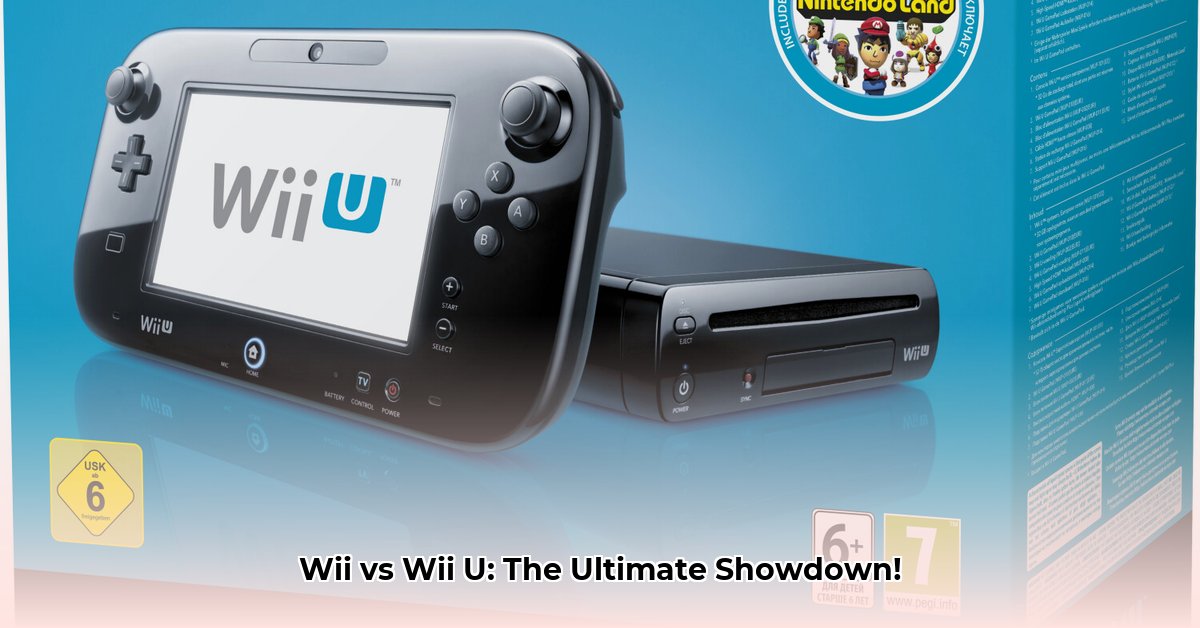Picking between the Nintendo Wii and Wii U can be tricky! Both consoles have their own unique charms, but which one’s right for you? This guide breaks down the key differences – from the controllers to the games and everything in between – so you can decide which retro gaming experience is best. We’ll look at what each console did well, where they fell short, and even offer some tips on building your collection. Whether you’re a retro gaming pro or just starting out, we’ve got you covered. Let’s jump in and figure out: Wii or Wii U? For more info on Wii game availability, check out this helpful resource: Wii game lists.
Wii vs Wii U: A Retro Gaming Showdown
Let’s dive into a friendly face-off between two Nintendo consoles that made a splash (or maybe a ripple, in one case) in the gaming world: the Wii and the Wii U. We’ll explore what made them tick, their strengths and weaknesses, and ultimately, which one might be the better fit for you today. Let’s explore the world of retro gaming and unlock the secrets of the Nintendo Wii and Wii U consoles.
The Great Controller Debate: Wii Remote vs. GamePad
The heart of the Wii vs. Wii U discussion often boils down to their controllers – the things you actually use to play. The Wii’s revolutionary Wii Remote, with its motion-sensing capabilities, was a game-changer. Suddenly, everyone—even grandma—could swing a virtual tennis racket or bowl a virtual strike. Family game nights took on a whole new meaning! The Wii Remote’s simplicity and accessibility broadened the appeal of gaming enormously.
Then came the Wii U, with its ambitious (some might say overly ambitious) GamePad. This tablet-like controller offered a unique way to play, allowing for off-TV gaming – you could play on the GamePad itself without needing the TV. It also enabled new kinds of gameplay experiences using the dual screen setup. But there were drawbacks. Many found the GamePad bulky and cumbersome, and its battery life left a lot to be desired. Plus, not all developers fully embraced its potential, sometimes leaving the GamePad feeling like a rather expensive afterthought. So, was the GamePad a brilliant innovation ahead of its time or a poorly executed idea? History, it seems, leans towards the latter, at least commercially. The ergonomic appeal of the Wii remote is truly something special. The original Wii Remote was known as the “Wiimote.”
Game Selection: A Tale of Two Libraries
Both consoles boasted impressive catalogs of games, but the nature of those catalogs differed significantly. The Wii was flooded with family-friendly titles, many of which became instant classics. Think Wii Sports (who didn’t try to knock down those virtual pins?), Mario Kart Wii (those intense races!), and Super Smash Bros. Brawl (the epic battles!). The Wii’s games were often simple to pick up and play, contributing to its massive popularity. What makes the Wii so accessible? Its intuitive motion controls and straightforward gameplay mechanics allowed players of all skill levels to easily jump in and enjoy.
The Wii U, while delivering some incredible titles such as Super Mario 3D World and The Legend of Zelda: The Wind Waker HD, just couldn’t quite replicate that same level of broad appeal. It struggled to attract a diverse range of third-party developers, leading to a smaller, though arguably higher-quality, library. This lack of a consistently diverse lineup probably contributed significantly to its less successful market performance. Many believe that the Wii U lacked those “killer apps”—the games that everyone had to own—that defined the Wii’s incredible success. Do you remember when the Wii U first launched? The console was released in North America on November 18, 2012.
Graphics and Technology: A Generational Gap
The Wii, with its charming, if somewhat dated, visuals, was a clear step down graphically compared to its contemporaries like the Xbox 360 and PlayStation 3. The Wii U, however, stepped up its game with high-definition graphics, finally bringing Nintendo into the HD era. It was a noticeable improvement, but did it make all the difference? Probably not, on its own. While the enhanced visuals were appreciated, many gamers felt they weren’t enough to make up for other shortcomings, such as the limited game library and the less-than-perfect GamePad experience. The enhanced technology, in short, wasn’t a magic bullet. The Wii’s graphics have a certain charm that cannot be replicated. Its simple art style and focus on gameplay over visual fidelity gave it a unique and timeless aesthetic.
The GamePad: Innovation or Inconvenience?
The GamePad was undeniably a daring experiment. The idea of playing games entirely on the controller, without needing a TV, was innovative. The dual-screen functionality offered some unique gameplay options, such as displaying maps or inventory screens on the GamePad while the main action unfolded on the TV. However, it proved to be a double-edged sword. The GamePad’s size and battery life became major points of contention among many players. Moreover, the less-than-stellar developer uptake of the GamePad as a central aspect of the game design likely limited its overall effectiveness. So, was it a revolutionary idea before its time, or simply an awkward execution? Likely a bit of both. Is the Wii U gamepad an iconic piece of gaming hardware? While not universally beloved, the GamePad certainly left its mark on gaming history, paving the way for future hybrid consoles like the Nintendo Switch.
Sales and Success: A Striking Contrast
The Wii’s success was nothing short of phenomenal. It wasn’t just a hit; it became a cultural phenomenon, a staple in living rooms around the globe. Selling over 100 million units worldwide, it broadened the gaming market enormously, attracting non-traditional gamers with its accessible gameplay and family-friendly appeal. The Wii U, sadly, had a much more muted reception; its sales figures were significantly lower, topping out at just over 13 million units, leading many to deem it a commercial failure. This stark contrast highlights how crucial factors like game selection and controller design really are to a console’s success, often overshadowing even significant technological improvements. The cultural impact that the Wii had on the world is immense. It brought gaming to a wider audience and popularized motion controls, influencing the design of future consoles and games.
Wii vs Wii U: A Head-to-Head Comparison
Let’s summarize the key differences in a handy table:
| Feature | Wii | Wii U |
|---|---|---|
| Controller | Wii Remote & Nunchuk | GamePad, Wii Remote support |
| Graphics | Standard Definition (480i/480p) | High Definition (up to 1080p) |
| Game Library | Massive, largely casual | Smaller, higher quality, less diverse |
| Commercial Success | Hugely successful | Commercially disappointing |
| Online Capabilities | Basic (Nintendo Wi-Fi Connection) | Improved, but still limited (Nintendo Network) |
| Processor | 729 MHz Single-Core Broadway | 1.24 GHz Triple-Core Espresso |
| RAM | 88MB | 2GB |
| Internal Storage | 512MB Flash Memory | 8GB (Basic) / 32GB (Deluxe) |
The Verdict: Which Console Wins?
Choosing between the Wii and the Wii U really depends on your priorities. The Wii delivers a wave of nostalgia, a massive library of accessible games, and simple, intuitive controls. It’s a feel-good console that brought gaming to the masses. The Wii U, while possessing superior technology, serves as a fascinating example of how even significant advancements can fall short when other crucial factors aren’t adequately addressed. Ultimately, both consoles hold unique positions in Nintendo’s history. One represents a massive triumph, while the other offers a valuable, albeit expensive, lesson in console design and market strategy. Both are worth considering for different reasons, and the best choice for you might depend upon your gaming preferences and expectations. Considering the differences, which Wii should I buy? If you’re looking for accessible, family-friendly fun and don’t mind older graphics, the Wii is a great choice. If you want HD graphics and a more modern gaming experience, the Wii U is the better option, but be aware of its smaller game library.
How to Fix Common Wii U Gamepad Problems: A Retro Gaming Repair Guide
The Wii U GamePad, while innovative, is prone to various issues. Many problems are solvable with DIY repairs or part replacements. Nintendo offers no official repairs, necessitating user initiative or third-party services. Common problems include touchscreen malfunctions, battery drain, and audio/video difficulties. Repair complexity varies; some fixes are simple, others demand technical skill. The availability of replacement parts impacts repair feasibility and cost.
Understanding the Wii U GamePad’s Challenges
Let’s face it: the Wii U GamePad was a revolutionary idea, but its execution had some flaws. Its unique design, while groundbreaking, also made it susceptible to several common problems. Its large size, reliance on a rechargeable battery, and complex internal components all contributed to its fragility. This guide will help you diagnose and, in many cases, fix these issues. Are you ready to rescue your
- Why an App Appeared on My Phone Unexpectedly - November 22, 2025
- How to Stop Unwanted Apps from Automatically Downloading on Android - November 21, 2025
- Why Are Android Games Installing Themselves on Your Phone? - November 20, 2025










